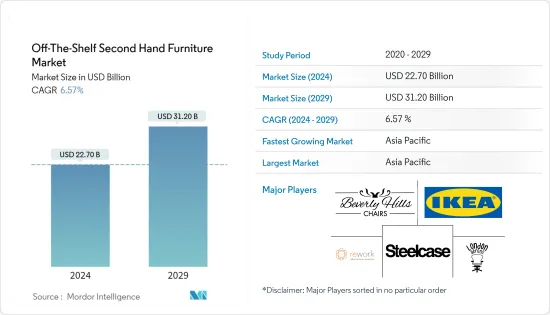
|
市場調査レポート
商品コード
1438421
中古オフザシェルフ家具:市場シェア分析、産業動向と統計、成長予測(2024~2029年)Off-The-Shelf Second Hand Furniture - Market Share Analysis, Industry Trends & Statistics, Growth Forecasts (2024 - 2029) |
||||||
カスタマイズ可能
適宜更新あり
|
|||||||
| 中古オフザシェルフ家具:市場シェア分析、産業動向と統計、成長予測(2024~2029年) |
|
出版日: 2024年02月15日
発行: Mordor Intelligence
ページ情報: 英文 120 Pages
納期: 2~3営業日
|
全表示
- 概要
- 目次
中古オフザシェルフ家具市場規模は2024年に227億米ドルと推計され、2029年には312億米ドルに達すると予測され、予測期間中(2024-2029年)のCAGRは6.57%で成長する見込みです。

市場が拡大しているのは、オンラインやオフラインのチャネルで中古家具製品が入手しやすくなっているためです。消費者はニーズを満たすことができる様々なデザインの家具を採用しています。中古家具の採用は、魅力的な価格帯で製品を入手できることに影響されつつあり、今後数年間の中古家具の需要に大きな影響を与えると予想されます。
COVID-19危機は、新しい技術に適応することによって、人々が買い物をする方法を変更しました。家具の買い物は、今やバーチャルで買うことを決定するようになっています。平均して、中古家具は50%以上安く、消費者は比較的安価に製品を入手できます。低価格が主な要因であるため、市場は拡大すると推定されます。
ミレニアル世代の人口が増加しているため、オンライン・チャネルを通じた販売が増加しています。これは、オンラインメディアを通じた中古家具の供給にプラスの影響を与えると思われます。市場の成長は、中古家具のコスト削減メリットと、世界中で消費者の節約志向の高まりによるものです。
中古家具市場の動向
オフライン流通チャネルが市場を独占
中古オフザシェルフ家具市場は、流通チャネルにセグメント化され、さらにオンラインとオフラインにセグメント化されるが、このうち、2021年の市場シェアが大きいオフラインセグメントが予測期間中に最大のシェアを占めると予想されます。しかし、スマートフォンユーザーの増加やインターネットユーザーの浸透に伴い、オンラインセグメントの市場シェアは予測期間中により高い成長率を示すと予想されます。
アジア太平洋地域が最も高い成長を遂げる見込み
アジア太平洋地域は予測期間中、収益面でより大きなシェアを占めると予想されます。中古品のオンラインマーケットプレースの規模が拡大していることが、アジア太平洋地域市場の成長を牽引すると予測されます。
さらに、アクセスのしやすさ、豊富な品揃え、中古家具の比較的安価な価格が、予測期間中の同地域の成長市場を牽引すると予想されます。この地域では、中国、日本、インドなどの国が最も顕著な市場となっています。
中古家具産業の概要
本レポートでは、中古オフザシェルフ家具市場で事業を展開する主要な国際企業を取り上げています。インドのマットレス市場は、国内ではIKEA、Beverly Hills Chairs、Steelcase、London Aeronsなどのプレーヤーによって支配されています。しかし、技術の進歩や製品の革新に伴い、中堅から中小の企業が新規契約の獲得や新市場の開拓によって市場での存在感を高めています。
その他の特典:
- エクセル形式の市場予測(ME)シート
- 3ヶ月間のアナリスト・サポート
目次
第1章 イントロダクション
- 調査の前提条件と市場定義
- 調査範囲
第2章 調査手法
第3章 エグゼクティブサマリー
第4章 市場の洞察と力学
- 市場概要
- 市場促進要因
- 市場抑制要因
- 産業バリューチェーン分析
- ポーターのファイブフォース分析
- 新規参入業者の脅威
- 買い手の交渉力
- 供給企業の交渉力
- 代替品の脅威
- 競争企業間の敵対関係
- 市場における技術革新に関する洞察
- COVID-19の市場への影響
第5章 市場セグメンテーション
- タイプ別
- キッチン用家具
- ダイニング用家具
- リビングルーム用家具
- バスルーム用家具
- 室内用家具
- 屋外用家具
- 用途別
- 住宅
- 商業
- 流通チャネル別
- オンライン
- オフライン
- 地域別
- 北米
- 欧州
- アジア太平洋
- 南米
- 中東・アフリカ
第6章 競合情勢
- 企業プロファイル
- IKEA
- Beveraly Hills Chairs
- Steelcase
- London Aerons
- Rework Chicago
- eBay Inc.
- Craiglist
- Etsy
- Amazon
- Yelp*
第7章 市場機会と今後の動向
第8章 付録
The Off-The-Shelf Second Hand Furniture Market size is estimated at USD 22.70 billion in 2024, and is expected to reach USD 31.20 billion by 2029, growing at a CAGR of 6.57% during the forecast period (2024-2029).

The market is increasing due to the rising availability of second-hand furniture products across online and offline channels. Consumers are adopting various furniture designs which can meet their needs. The adoption of second-hand furniture is getting influenced by the availability of products at an attractive price range which is expected to affect the significant demand for second-hand furniture in upcoming years.
The COVID-19 crisis has altered how people shop by adapting to new technologies. Shopping for furniture is now a decision to buy virtually. On average, second-hand furniture is more than 50% cheaper, allowing consumers access to the products at comparatively less cost. Low cost being the primary factor, is estimated to expand the market.
The rising millennial population has been paving the way for rising sales through online channels. This will positively impact the supply of second-hand furniture through online media. The market's growth is owing to the cost-saving benefits of second-hand furniture and the increasing desire of consumers to save money across the globe.
Second Hand Furniture Market Trends
Offline Distribution Channel is Dominating the Market
The Off-the-Shelf Second Hand Furniture Market is segmented into the distribution channel, which is further segmented into online and offline, out of which the offline segment, with a larger market share in 2021, is anticipated to have the largest share during the forecast period. However, with the rise of an increasing number of smartphone users and increasing penetration of internet users, the market share for the online segment is expected to grow at a higher rate over the forecast period.
Asia-Pacific is Expected to Witness the Highest Growth
The Asia Pacific is expected to account for a larger share in terms of revenue during the forecast period. The increasing size of the online marketplace for second-hand goods is anticipated to drive the growth of the Asia Pacific regional market.
Additionally, ease of accessibility, availability of a large variant of products coupled with comparatively low cost of second-hand furniture is anticipated to drive the growth market in the region during the forecast period. Countries such as China, Japan, and India have the most prominent market in the region.
Second Hand Furniture Industry Overview
The report covers major international players operating in the Off-the-Shelf Second Hand Furniture Market. The Indian mattress market is domestically dominated by players such as IKEA, Beverly Hills Chairs, Steelcase, London Aerons, and others. However, with technological advancement and product innovation, mid-size to smaller companies are increasing their market presence by securing new contracts and tapping new markets.
Additional Benefits:
- The market estimate (ME) sheet in Excel format
- 3 months of analyst support
TABLE OF CONTENTS
1 INTRODUCTION
- 1.1 Study Assumptions and Market Definition
- 1.2 Scope of the Study
2 RESEARCH METHODOLOGY
3 EXECUTIVE SUMMARY
4 MARKET INSIGHTS AND DYNAMICS
- 4.1 Market Overview
- 4.2 Market Drivers
- 4.3 Market Restraints
- 4.4 Industry Value Chain Analysis
- 4.5 Porter's Five Forces Analysis
- 4.5.1 Threat of New Entrants
- 4.5.2 Bargaining Power of Buyers
- 4.5.3 Bargaining Power of Suppliers
- 4.5.4 Threat of Substitutes
- 4.5.5 Intensity of Competitive Rivalry
- 4.6 Insights on Technological Innovations in the Market
- 4.7 Impact of COVID-19 on the Market
5 MARKET SEGMENTATION
- 5.1 By Type
- 5.1.1 Kitchen Furniture
- 5.1.2 Dining Furniture
- 5.1.3 Living Room Furniture
- 5.1.4 Bathroom Furniture
- 5.1.5 Indoor Furniture
- 5.1.6 Outdoor Furniture
- 5.2 By Application
- 5.2.1 Residential
- 5.2.2 Commercial
- 5.3 By Distribution Channel
- 5.3.1 Online
- 5.3.2 Offline
- 5.4 Geography
- 5.4.1 North America
- 5.4.2 Europe
- 5.4.3 Asia-Pacific
- 5.4.4 South America
- 5.4.5 Middle East and Africa
6 COMPETITIVE LANDSCAPE
- 6.1 Company Profiles
- 6.1.1 IKEA
- 6.1.2 Beveraly Hills Chairs
- 6.1.3 Steelcase
- 6.1.4 London Aerons
- 6.1.5 Rework Chicago
- 6.1.6 eBay Inc.
- 6.1.7 Craiglist
- 6.1.8 Etsy
- 6.1.9 Amazon
- 6.1.10 Yelp*


